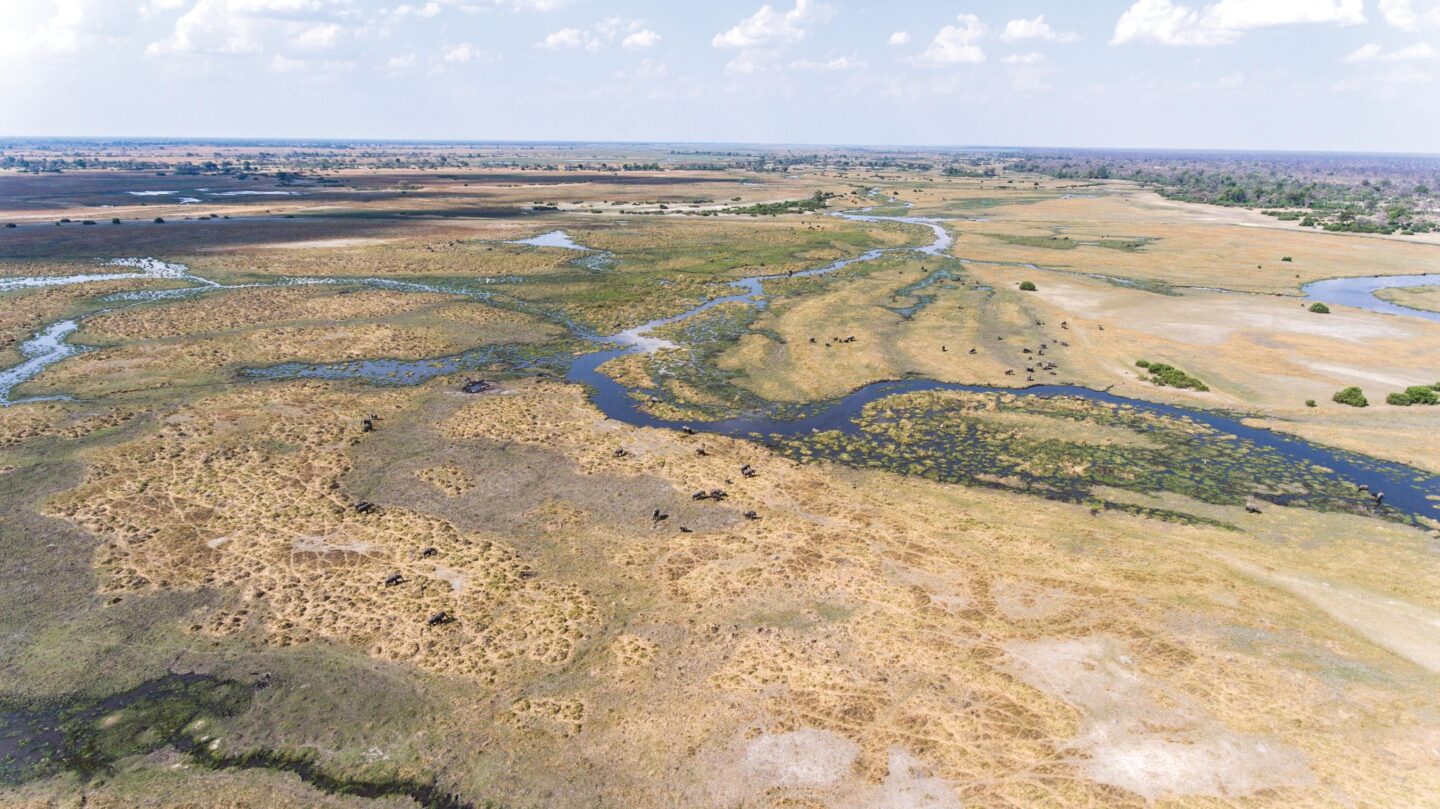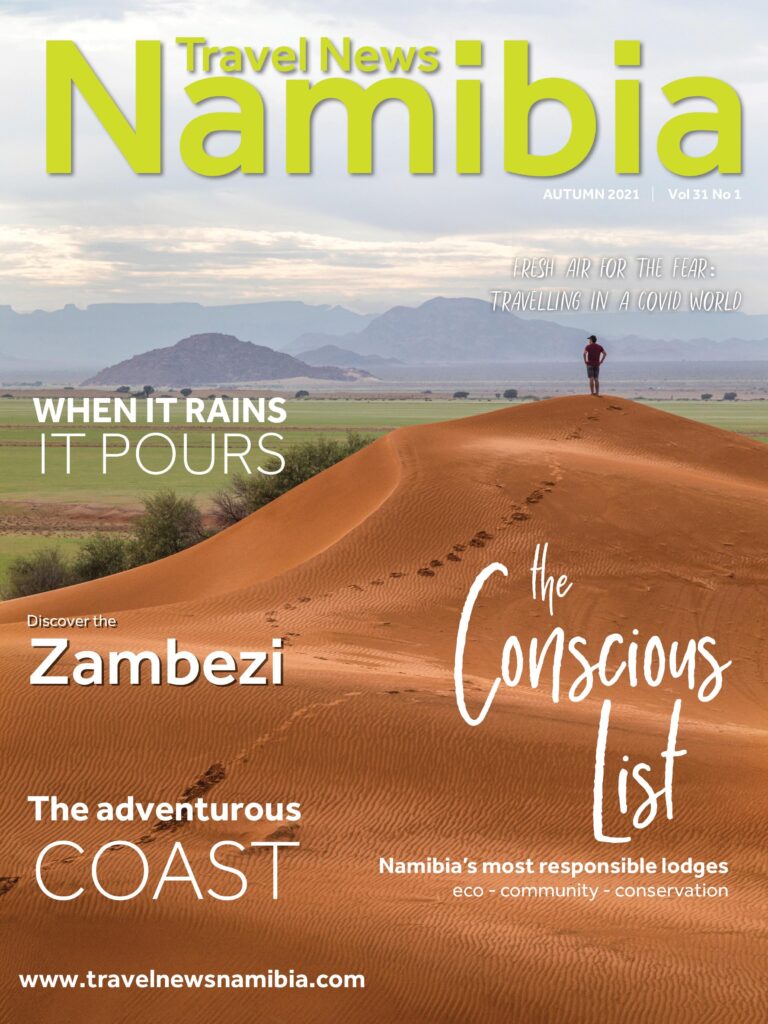

It’s time to explore the
Zambezi
Namibia as a travel destination has become known for cliché phrases such as ‘wide open spaces’, ‘desert vistas’, ‘rolling dunes’ and ‘desert-adapted’, to name but a few. Yet, in the country’s oddly shaped north-eastern arm is a wild, natural playground that is surprisingly accessible considering its largely unspoilt wilderness. It is an area that contains winding waterways, wetlands, floodplains, forests, grasslands and the host of wonderful creatures big and small that inhabit these different ecosystems. Le Roux van Schalkwyk delves deeper into what makes this corner of Namibia unique and a must-see during your visit.
From the Autumn 2021 issue
The Zambezi Region derives its name from the legendary Zambezi River. The river forms the north- eastern border of the region, starting from Katima Mulilo. From here it flows southeast to the tip of the country and Impalila Island, its easternmost point. It is the rather unique intersection of four countries: Namibia, Zambia, Botswana and Zimbabwe. This is also the point where the Chobe flows into the mighty Zambezi. The Chobe straddles the south-eastern border of the region along with its preceding rivers, the Linyanti and Kwando. Two of Namibia’s five perennial rivers are found in the Zambezi Region, known for large populations of elephant and buffalo which congregate along these waterways during the dry winter months. Furthermore, thanks to the varied habitats, it is rich in other wildlife that includes leopard, lion and the endangered African wild dog. The lush vegetation and plentiful water attracts a myriad of bird species while the rivers harbour plenty of life that includes crocodile and hippo.
The region isn’t only a wildlife haven but it is also rich in culture, the heritage, traditions and customs of several ethnically different tribes. Most of the area is communal land which is dotted with villages and farms where the majority of the population are subsistence farmers.
The western Bwabwata National Park is the dry arm of the region and covers a stretch of more than 150 km between the Okavango River and the western bank of the Kwando River.
The park is unusual in the sense that most of the 6 274 km2 that it covers are zoned as a multiple use area. Three sections are designated for special protection and controlled tourism: the Kwando, Buffalo, and Mahango Core Areas. This means that 4 055 km2 of the park are designated for sustainable community-based activities such as tourism, and they contain the settlements of the local people.
Even though Bwabwata is a sanctuary to 35 large game species, including sitatunga and Chobe bushbuck, tsessebe and numerous small-game species, large numbers of animals congregate along the Okavango and Kwando riverbanks due to the lack of surface water throughout most of the park. The well-known Horseshoe Bend in the Kwando Core Area is popular among visitors. This u-shaped lagoon with its white beach on the western bank is a favourite drinking and bathing spot of elephants and attracts massive herds between midday and late afternoon.
Mudumu National Park is one of the lesser-known wildlife reserves and at 1 000 km2 one of the smallest parks in Namibia. It is nestled between the Mashi and Balyerwa conservancies, roughly 30 km south of Kongola, and lies on both sides of the main road that leads to Sangwali. Separated from neighbouring communal farmland by a graded cutline, wildlife can move freely into and out of the park. While it serves as an excellent corridor for wildlife migration between Botswana, Zambia, Angola and Zimbabwe, it can also cause problems with local subsistence farmers. Conservancies have, however, played a major role in mitigating human-wildlife conflicts, a fact that adds to making the park special.
Since its proclamation in 1990, and with cooperation from the surrounding conservancies, wildlife including a large elephant population has now returned to Mudumu. Where three decades ago very few animals were seen due to decades of poaching, wildlife has largely recovered.
To the west, the park borders the Kwando River for about 15 km. Thanks to the almost completely flat landscape, the track that follows the river and traverses the floodplain and associated grasslands makes for great game viewing. Whereas the western side of the park offers brilliant views of the scenic riverine area, the eastern side is the Mudumu Mulapo fossilised river course with extremely dense mopane woodland. Even though visibility is much more limited, visitors are more likely to see game such as eland, giraffe or zebra.
“The region isn’t only a wildlife haven but it is also rich in culture, the heritage, traditions and customs of several ethnically different tribes”
Nkasa Rupara National Park, the largest wetland area in Namibia that has conservation status, is a natural haven for wetland species.
Originally known as Mamili, it was proclaimed a National Park just before independence on 1 March 1990. In 2012, the 320 km2 park was renamed after the two Kwando River islands in its boundaries: Nkasa and Rupara.
Nkasa Rupara is situated where the Kwando becomes the Linyanti River. The two rivers form the western (Kwando) and the south-eastern (Linyanti ) borders of the park and create a crooked V-shape. The park is a wetland of note: it consists of an array of channels and lagoons with lush marshes, dense savannah dotted with termite mounds and tall river reeds. The area is also extremely flat and therefore up to 80% of the park is swamped when the annual flood waters arrive from Angola via the Kwando. As a result, only Rupara Island is accessible, whereas the track to Nkasa Island is blocked due to deep channels.
The park is full of life and Namibia’s own Okavango delta, although on a much smaller scale. More than 400 species of birds have been recorded which, considering its size, makes it a rewarding hunting ground for bird-watchers. The area also attracts more than 1 000 buffaloes, the largest concentration in the country. Other species of wildlife are abundant as well, especially impala and lechwe, and the park is considered as a core breeding area for wildlife that can disperse into neighbouring conservancies. Boat cruises allow for amazing hippo sightings, apart from being a fantastic way to explore the Linyanti swamps.
Even though there are no proclaimed parks on the Namibian side of the Zambezi River, there are excellent accommodation establishments overlooking the river. With the large number of bird species that live along this life-sustaining river, the area is superb for bird watching. Boat trips on the river guarantee great sightings of African skimmers, kingfishers, fish eagles and for the lucky few, Pel’s fishing owl. Between late August and December, several breeding colonies of Southern carmine bee-eaters are active along the Zambezi River. One of the biggest colonies in southern Africa breeds on the main river bank close to Kalimbeza Island. Between 3 000 to 5 000 birds are estimated to congregate there during those months – a sight to behold!
Looking to explore the Zambezi? Check out The Namibian Wetlands Route for a wide selection of establishments across the region.
The Zambezi Region is often seen as a mere overnight stop on the way to neighbouring attractions like Victory Falls. But it is very much a destination in its own right. The perennial rivers and expansive floodplains, lush tropical vegetation and absolute abundance of game and birds creates a surprising contrast to the rest of the country. The more time one spends there, the more one can really experience all the treasures the Zambezi Region has to offer. Boat trips on the rivers provide exciting opportunities to view hippos, elephants and crocodiles, as well as scores of antelope. Fishing, especially tiger fishing, is a popular activity. Local villages and settlements are vibrant with life and visitors have the opportunity to take home baskets and wooden ornaments skilfully made by hand, or visit living museums to learn about ancient and modern traditions. This wild and adventurous destination is surprisingly accessible. Two tarred highways provide easy access to lodges and sights. The parks should only be entered with 4×4 vehicles. For guests without those, most lodges offer game drives which also means that you can enjoy the beautiful wildlife and scenery even more.
A dramatic contrast to the rest of Namibia, the wet and wild wilderness of Zambezi teems with life and exciting adventures. Now it’s up to you to go and experience it for yourself. TNN






